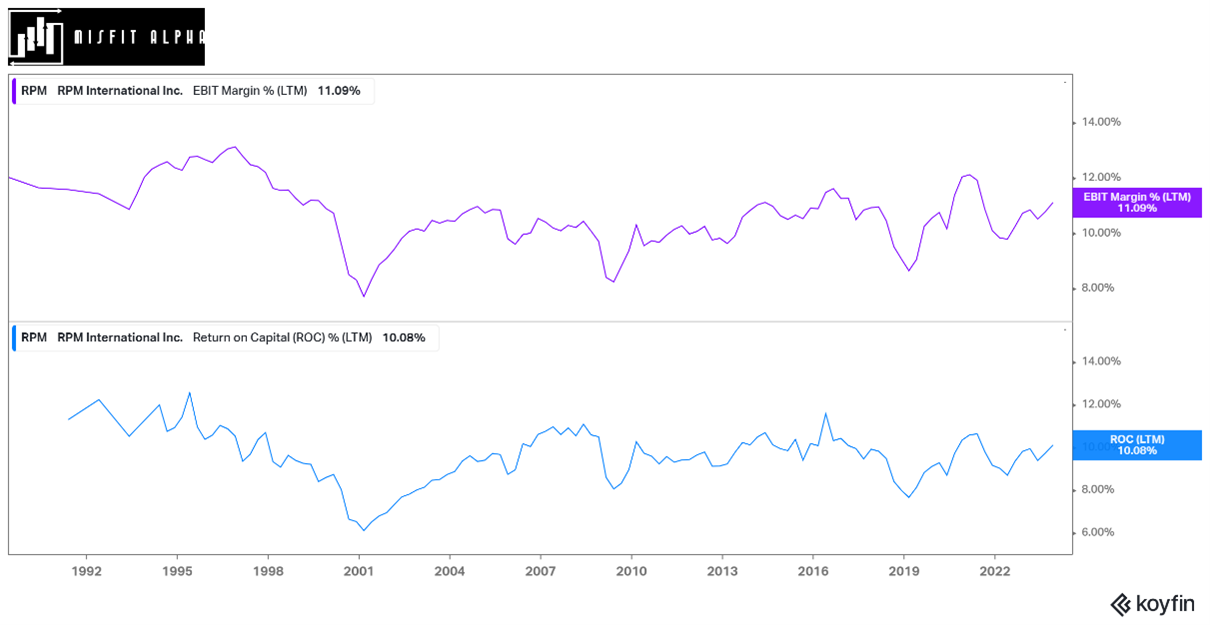One thing that sticks out in Common Stocks, Uncommon Profits is Fisher’s love for chemical companies. He gushed about Dow Chemical (DOW) and E.I. DuPont de Nemours (DD) as if they were his children. That brings me to RPM International (RPM), explains Tyler Crowe, author of Misfit Alpha.
In Fisher’s time, chemical companies were like semiconductor companies today. They built revolutionary products that multiplied yearly and transformed nearly every facet of life. The chemical industry isn’t the hot industry it was anymore. Many of its products have become commoditized and traded on a global scale. Dow and DuPont, once the incubators of human progress, are shells of their former selves.
Despite the maturity of the chemical industry in the US and its cyclicality, several companies have continued to generate stellar returns for investors. Ironically, some of the best-performing companies in the industry don’t produce innovative products.
A tremendous and perhaps well-known version of this phenomenon is Sherwin-Williams Co. (SHW). Innovation and house paint rarely go hand in hand. Still, it is a business that has generated spectacular returns thanks to efficient operations, some modest pricing power, and a focus on capital returns.
If you have used a Sherwin-Williams product, then there is a decent chance you’ve also used an RPM product without even knowing it. The ubiquitous chemical manufacturer has been a stellar performer in its own right, producing a 62,800% return since its IPO in 1971.
To list all of the products RPM produces would take me longer than it took Bubba to name all the ways you could have shrimp in Forrest Gump. The 10-K alone lists hundreds of coatings, sealants, glazing, varnish, caulks, resins, epoxy, insulation, composite flooring, and fireproofing products, to name a few. Its most recognizable consumer brands are Rust-Oleum metal coating, DAP caulk & sealants, and Zissner paint primer.
Perhaps the best way to distill RPM’s business down to a few sentences is that it’s a bet on North American economic activity. Roughly 79% of its revenue comes from North America, so increased construction, manufacturing, and any other economic activity related to making tangible products will likely benefit RPM.
M&A has been in this company’s DNA for decades. The company started in 1947 as Republic Powdered Metals with a single product (an aluminum roof coating). It made its first acquisition in 1966 and hasn’t looked back.
One thing it has in common with other serial acquirers that create shareholder value is it primarily focuses on smaller targets. It spent $405 million from 2020-2023 for 21 acquisitions, which gives you a rough idea of its target business size.
Financially speaking, no one is going to write home about this company. Revenue has grown at a 5.3% annualized rate over the past decade. But it makes up for its slow growth with rather remarkable consistency. EBIT margins have remained above 9.5% for the past 35 years. Even at the worst of the pandemic, the great recession, and the early 2000s recession, its EBIT margins remained above 7.5% and returns on capital exceeded its cost of capital.

Plus, RPM is one of those few companies that have raised dividend payments for over 50 years in a row. And it’s in an industry that will be hard to replace. Manufacturing, construction, and home repair are the types of things that will continue in some form forever.
Recommended Action: Buy RPM





















